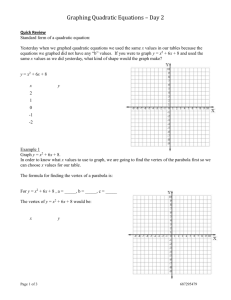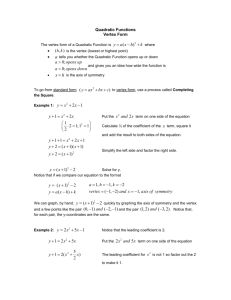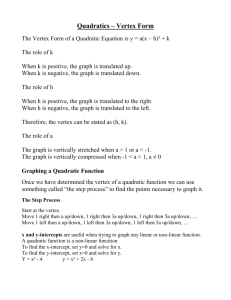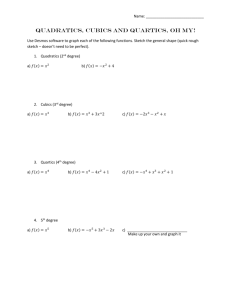Chapter 9- Solving Quadratics
advertisement
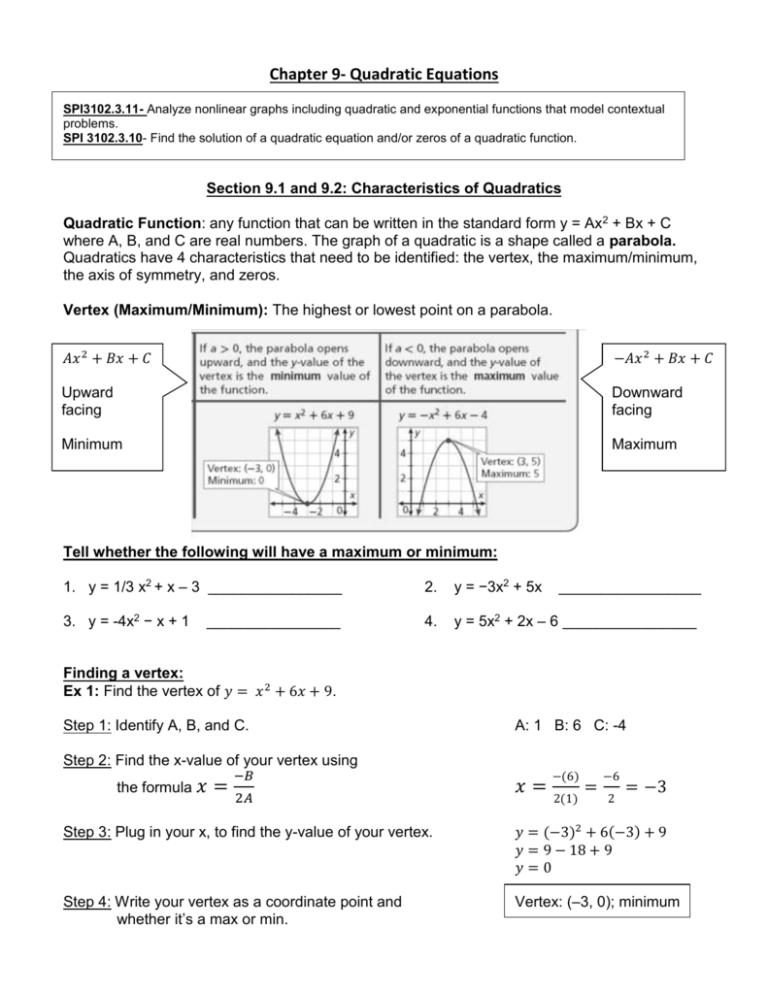
Chapter 9- Quadratic Equations SPI3102.3.11- Analyze nonlinear graphs including quadratic and exponential functions that model contextual problems. SPI 3102.3.10- Find the solution of a quadratic equation and/or zeros of a quadratic function. Section 9.1 and 9.2: Characteristics of Quadratics Quadratic Function: any function that can be written in the standard form y = Ax2 + Bx + C where A, B, and C are real numbers. The graph of a quadratic is a shape called a parabola. Quadratics have 4 characteristics that need to be identified: the vertex, the maximum/minimum, the axis of symmetry, and zeros. Vertex (Maximum/Minimum): The highest or lowest point on a parabola. 𝐴𝑥 2 + 𝐵𝑥 + 𝐶 −𝐴𝑥 2 + 𝐵𝑥 + 𝐶 Upward facing Downward facing Minimum Maximum Tell whether the following will have a maximum or minimum: 1. y = 1/3 x2 + x – 3 ________________ 2. y = −3x2 + 5x 3. y = -4x2 − x + 1 4. y = 5x2 + 2x – 6 ________________ ________________ _________________ Finding a vertex: Ex 1: Find the vertex of 𝑦 = 𝑥 2 + 6𝑥 + 9. Step 1: Identify A, B, and C. A: 1 B: 6 C: -4 Step 2: Find the x-value of your vertex using −𝐵 the formula 𝑥 = 2𝐴 𝑥= −(6) 2(1) = −6 2 = −3 Step 3: Plug in your x, to find the y-value of your vertex. 𝑦 = (−3)2 + 6(−3) + 9 𝑦 = 9 − 18 + 9 𝑦=0 Step 4: Write your vertex as a coordinate point and whether it’s a max or min. Vertex: (–3, 0); minimum Ex 2: Find the vertex of 𝑦 = 𝑥 2 − 4𝑥 − 10 Vertex: ___________ Max or Min? __________ Axis of Symmetry: The vertical line that divides a parabola into two symmetrical halves. Finding the Axis of Symmetry: Ex 3: Find the axis of symmetry of the graph: Step 1: Identify the vertex. Vertex: (–1, 0) Step 2: The axis of symmetry is the x-value of the vertex. Axis of symmetry: x = –1 Max or min: Minimum Ex 4: Find the axis of symmetry of 𝑦 = 2𝑥 2 + 𝑥 + 3 Step 1: Find the x-value of your vertex using 𝑥 = −𝐵 2𝐴 . Step 2: The axis of symmetry is the x-value of the vertex. 𝑥= −(1) 2(2) = −1 4 Axis of symmetry: x = −1 4 You Try! A) Find the axis of symmetry of the graph. HW: TB pg. 624, #22-33 B) Find the axis of symmetry: 𝑦 = 𝑥 2 + 4𝑥 − 7 Section 9.5, 9.6, and 9.9: Solving Quadratic Equations We are now going to learn how to solve Quadratics. To solve a Quadratic you have to find the zeros of the function. You can do this 3 different ways: graphing, factoring, and the quadratic formula. Zeros: The x-value(s) that make the function equal to zero (the x-intercepts). Finding Zeros of a Quadratic Equation: Graphing Ex 1: Find the zeros of the graph: By looking at a graph: You look to see where the parabola crosses the x-axis. Zeros: _____________ You Try! A) Find the zeros of the graph. B) Find the zeros of the graph. Finding Zeros of a Quadratic Equation: Factoring Ex 2: Find the zeros of y = x2 - 6x + 8. Step 1: Set the quadratic equal to zero. 0 = x2 - 6x + 8 Step 2: Factor the quadratic. 0 = (x – 4)(x – 2) Step 3: Set each factor to zero and solve. x-4=0 +4 +4 x=4 Zeros: x = 4 and 2 x–2=0 +2 +2 x=2 x2 + 4x = 21 Ex 3: Ex 4: x2 – 12x + 36 = 0 Ex 5: -2x2 = 20x + 50 Ex D: x2 + 4x = 5 Ex E: 3x2 – 4x + 1 = 0 YOU TRY! Solve by factoring. x2 – 6x + 9 = 0 Ex C: Finding Zeros of a Quadratic Equation: Quadratic Formula Quadratic Formula: x= b b 2 4ac 2a Solve 2x2 5x 12 0 using the quadratic formula. 2x2 5x 12 = 0 Step 3: Simplify. x ( 5) ( 5) 2 4(2)( 12) 2(2) x Step 1: Identify a, b, and c. a2 5 25 ( 96) 4 x 5 121 4 c 12 x 5 11 4 Step 2: Substitute into the quadratic formula. Step 4: Write two equations and solve. b 5 x ( 5) ( 5) 2 4(2)( 12) 2(2) x 5 11 4 x4 5 11 4 or x or x 3 2 Ex 6: 6x2 + 5x - 4 = 0 Ex 7: 2x2 = 5x + 4 YOU TRY!!! Solve using the Quadratic formula. Ex F: -3x2 + 5x + 2 = 0 HW: TB pg. 679, #1-13, 25-27 Ex G: 3 - 5x2 = -9x


